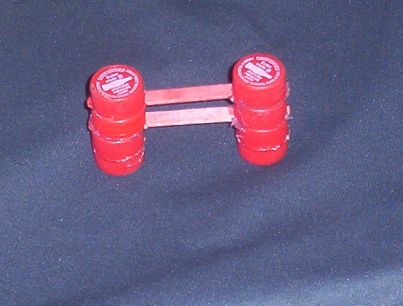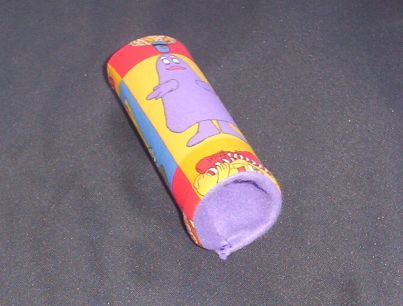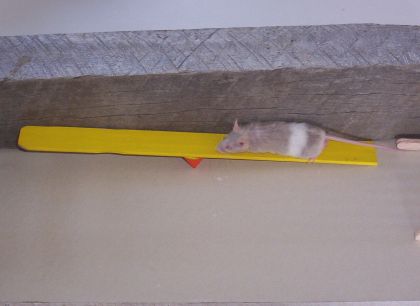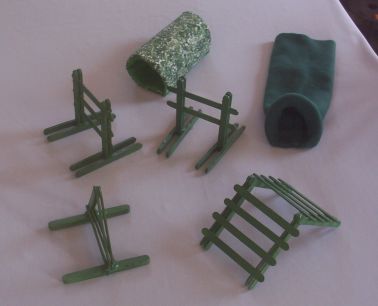|
Mouse Agility Equipment
and/or Dwarf Hamster Agility Equipment

Mice can be easy to train for or to agility because they naturally run along a wall and run the same way/path each time. If you set your agility course up along a wall or make a short wall (books or wood or even using a sheet of paper to guide the mouse along the course) will help in training.
The equipment needs to be mouse size, not too big and not too small. It needs to be stable enough and safe enough for your mouse to run on and it not tip over or collapse on or with the mouse. Make sure there are no sharp edges on any of the equipment. Decorate to add a touch of fun and train away.
If you have ever trained dogs for agility and hauled their equipment...you will love mouse agility. Most, if not all of the course equipment will fit into a shoe sized storage box. Several of the pieces will fit into your coat pocket.

Mice do need their own set of agility equipment. They will not share well with your hamster or other small animals. Mice have this thing about smelling other animals on their stuff and they might just think that the animal they smell is near and out to hurt them (think like an animal, the little mouse thinks it may be killed and eaten). Don't misunderstand, you can use the same equipment for more then one mouse. Just don't use the same equipment for a hamster and or gerbil and a mouse, or the mouse will not go along as well as it would on equipment that only mice have used.
Mice can be great pets. If you work with them you will find training easier the you first think. Most mice enjoy spending time with their owners too. So the more time you spend together the more your little bitty pet will learn.
As for as size of the equipment, while Mice and Dwarf Hamsters can use some of the same sized items a gerbil or hamster agility equipment, they will also need some smaller items or pieces. Just as some of the rat agility equipment is too large for a gerbil, some of the gerbils items are too big for a mouse.
The agility equipment needs to be built well enough to support a mouse's weight, remember many, if not all mice, will climb the piece rather then just jump it.
If you build your items make sure you use items that are safe and have no sharp edges. Make sure it will support the weight of the tiny animal in a safe manner. Use safe paints. Painting or sealing the surface your equipment is important so that you can keep it clean (think urine) and safe for your small pets.
If you are teaching your mouse to run an agility course do not let them have the same type items in their cage to play on or sleep in. For example, you will have a hard time teaching a mouse to run through a tunnel on a course if they sleep in one in their cage.

FENCE JUMP
Fence Jumps are made to look like a fence that a horse would be behind in the country. Why? Because all animal agility, all, meaning dog, cat, rat, gerbil, mouse all or any species came from the idea of Steeple Chase. An event horses compete in by jumping over all kinds of pretty and functional fences...well, cut outs if you will. The event can also be called "Show Jumping".

So you will see, even in mice agility, fence jumps on about every agility course that is set up.
This is also the reason some folks call all the jumps and or all agility equipment "fences". Many people also refer to the small animals agility or jumping courses as "Show Jumping" or Showjumping".

BAR JUMP
Bar Jumps are made with "bars" that are the same height in either side of the matching sides. Most bar jumps are adjustable.
Bar Jumps are usually where you will see the most artsy type jumps at an event. It is fun to make the course a pleasure to look at and have a little fun while making your equipment.

Some, but not all, Bars or polls are made to fall if hit while the animal is coming over it and hits the top bar.
Be sure to start the animal with low bars when first training these pieces of equipment.

STATIONARY BAR JUMPS
This is a fun little Coke Bar Jump. The jumps do not have to be fancy, but functional and stable.
I have directions on how I made this on our craft page.
The edges look a bit unsightly not because I was sloppy, but that I added glue to the area where the caps were put together to give the jump more strength.

I also have this type of Stationary Bar Jump. This one could also qualify for a Fence Jump. It works well and is stable enough for a gerbil or hamster or even a small or young rattie.

TIRE JUMP
These are cute. It all started when Dog Agility started mounting tires for one of the jumps the dogs jumped through. It was such a cute idea and a big crowd pleaser so the Tire Jump became a staple in a course.

With tires coming in all sizes, including the itty bitty for dog toys, now even mice can have a Tire Jump....and it is a really cute item on the course too!!
I love this piece and that little pet you see coming through it!! LOL

HOOP JUMP
Hoop Jumps are jumps that the animal jumps through. It may have a round or triangle or even square or rectangle shape to it.
The hoop of the jump is a separate piece that attaches to a stand of some sort. Many are very decorative.
For mice there are so many items you can use for the hoop of the jump. Some washers are large enough to use. You do not want something too big or too small.
Most animals will easily be taught to jump through a Hoop Jump.

WINDOW JUMP
A Window Jump is a jump made with a solid piece of wood, plastic or fabric with a "window" cute out. Usually the "window" is a bit bigger then say the hoop of a hoop jump.
The Window Jump can be any shape but is usually round or rectangular with the taller side up and down.
Window Jumps are usually (by any species) climbed when first started and many times always climbed through (by small animals).

HICKORY DICKORY CLOCK JUMP
OK, so it is really just a Window type jump. LOL
I love this one. It came as a lid on a small bucket full of Lego type lock blocks I wanted to use for small animal agility equipment building....then I got the idea for the Mouse Jump.
So as you can see? You can do a lot with a little. The mouse will jump through this one in the circle above the six on the clock.

OPEN TUNNEL
An Open Tunnel for a mouse does not need to be much larger then a toilet paper roll.
It should be either plastic, PVC or fabric with a stiff center so that it can be cleaned when needed.
For competition, if using fabric, there should be at least three and surly five that are exactly alike, same color, same fabric, same inside so that each animal has the same experience when they go through it.
This one has a polar fleece center with plastic inside for shaping. I like to use fun fabrics for these items. This one reminds me of a Drive Thru or Run Through....it's a hap, hap, happy place...the agility course. <smile>

CLOSED TUNNEL
The Closed Tunnel should have one end open and a drape in the "fabric" with a closed end.
This one I use for my mice. It is approx 8" long with a 2" opening. It is made with polar fleece that is washable.
This is the piece you really have to train for...the small animals run right in to them, the training is to teach them to come out the other end.

RUN THROUGH
A Run Through is a bit like a tunnel. It is an item that the animal runs through, goes in one way and comes out another, but not a tube or a tunnel.
This one is a Mouse House Run Through. The mouse goes in through the cut out for the 0 and comes out th cut out for the number 6 on the side.
WEAVE POLLS
Weave Polls are a series of 5 to 7 polls that the mouse will "weave" (go to the left of the first, right of the second, left of the third and so on) through.
The polls are set up in a row, some weave polls are set up staggered, and the mouse walks to the left of the first, right of the second, left of the third and so on.
I have seen some really cute ideas for tiny Weave Polls. I have seen playdough used to hold polls, small dolls used, toilet paper rolls, the ideas are endless.
Make sure that the stand that you attach your Weave Polls to is stable. The mouse may bump into a poll or two and they need to stay upright, where they were placed and not fall over on or near the mouse and scare it.

"A" FRAME
An "A" Frame is a "walk", if you will, that from the end is shaped like a capital letter A. It has some sort of planks, slats, or steps for the animal to climb up one side and down the other.
This piece is usually a favorite with animals....dog, cats, rats, mice, most animals really enjoy scaling the "A" Frame.
This little guy is Red Hearts. It is his very first time on the A Frame...I of course think he is as cute as a button!!

This one is painted as all agility equipment needs to be so that it can easily be cleaned if needed (think urine).

TEETER TOTTER
Teeter Totters are a fun piece of agility equipment. Everyone loves the Teeter Totter. Make sure while training this piece to your animals that you go slow and keep it low until they get used to the teeter. Remember, when they first begin, it feels like the ground is dropping out from under them.
A Teeter Totter for a mouse should be approx. 1" x 12". The teeter or pivot should not be more then 1" and 1/2" would be best.

The Teeter Totter like all pieces should be painted with a paint that can easily be cleaned with a wipe.
The Teeter Totter is smaller then the Sea Saw and should be taught to the animal first. Teach the Sea Saw only after the animal feels safe and stays on the Teeter Totter as it pivots.
SEA SAW
The piece should be approx. 1 1/2" wide, by 8" - 12" long with a 2" pivot, or teeter (break over).
The piece must be stable or wide enough to hold the animals weight even if the animal is running off center, so when you add height you must also add width to the platform to make it safe for your mouse..
Remember to train the mouse to the Teeter Totter first. The Teeter totter is a shorter Sea Saw. Remember when the mouse walks on the Teeter Totter or Sea Saw, it feels like the ground is dropping under it when it pivots. Take training for this piece slowly, it will be worth it.

THE SET
This seven piece set (including the plastic storage box the items come it) is a great starter set for gerbils, regular and dwarf hamsters, mice, mouse, a small or very young rat, rattie, rats.
It comes with two Stationary Bar Jumps, one with two bars the other with three bars, a Triangle Hoop Jump, an A Frame, and a Fabric Open Tunnel as well as a fabric Closed Tunnel.
While not competition equipment, still fun and functional and great for training and having a great time at home or with friends that also own small animals. It is also recommended for entertaining friends and family with your small pets antics!!
We sell these in our on site stores to encourage people to get started in this fun and exciting sport....small animals love the equipment and the time spent with you.
You can use it just as it is and or add jumps and other equipment as your small pet learns to maneuver the course you set up for it.
The contents of this page for Mouse and Dwarf Hamster Agility Equipment is still under construction. This site will be a work in progress, please check back often.
-- The Gerbil Agility Team
| 



 In the high plains of South Dakota, USA
In the high plains of South Dakota, USA In the high plains of South Dakota, USA
In the high plains of South Dakota, USA